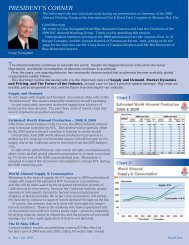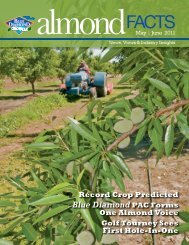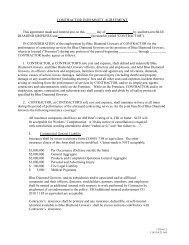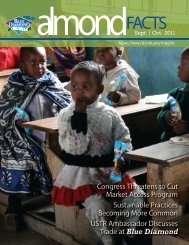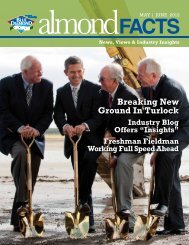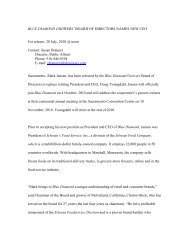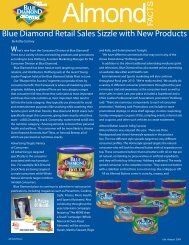View the PDF - Blue Diamond Growers
View the PDF - Blue Diamond Growers
View the PDF - Blue Diamond Growers
You also want an ePaper? Increase the reach of your titles
YUMPU automatically turns print PDFs into web optimized ePapers that Google loves.
The Bee BoxCHRISTI HEINTZ& MEG RIBOTTOWith <strong>the</strong> 2013 almond bloom right around<strong>the</strong> corner, growers may be wondering whatto expect in bee strength and availability in<strong>the</strong> coming months. Initial reports appearedencouraging. Total losses of managedhoneybee colonies in <strong>the</strong> United Statesdropped to 21.9 percent for <strong>the</strong> 2011-2012 overwinteringseason. That number was downfrom <strong>the</strong> approximately 30 percent averageloss beekeepers had experienced in <strong>the</strong> 2010-2011 survey conducted by <strong>the</strong> USDA- AIAand Bee Informed Partnership (BIP). Oneexplanation was <strong>the</strong> wea<strong>the</strong>r. Winter wasunusually warm; in fact, January 2012 was <strong>the</strong>fourth warmest January in U.S. history.»<strong>Growers</strong> can help beekeepers locate and stage colonies nearavailable bee forage while <strong>the</strong> bees wait for almond bloom.December- and January-blooming mustards provide goodbee nutrition. Photo by Christi HeintzTHE BEE BOX“A warm winter means less stress on bee colonies and may help <strong>the</strong>m be more resistantto pathogens, parasites and o<strong>the</strong>r problems,” said Dr. Jeff Pettis, co-leader of <strong>the</strong> surveyand research leader of <strong>the</strong> USDA-ARS Bee Research Laboratory in Beltsville, MD. Dr.Dennis vanEngelsdorp, University of Maryland, fur<strong>the</strong>r added, “One in five bees lostis still huge and still quite a ways from <strong>the</strong> 13-14 percent loss beekeepers say would besustainable.” January started out “warm” but what soon followed in <strong>the</strong> coming monthswas to become one for <strong>the</strong> record books.Simply put, it was a tough summer for farmers in most of <strong>the</strong> country. One of thisyear’s top news stories was <strong>the</strong> wea<strong>the</strong>r. The most severe and extensive drought in atleast 25 years seriously affected U.S. agriculture, according to <strong>the</strong> USDA-EconomicResearch Service and <strong>the</strong> U.S. Drought Monitor.With <strong>the</strong> crippling drought came <strong>the</strong> heat. The U.S. experienced <strong>the</strong> third hottestsummer ever. And <strong>the</strong> year-to-date (January through August) period was also <strong>the</strong>warmest first eight months ever recorded for <strong>the</strong> contiguous U.S., according to <strong>the</strong>National Oceanic and Atmospheric Administration (NOAA), whose records go backto 1895.The drought and heat <strong>the</strong>n fueled wildfires. As of this past August, nearly 7 millionacres had been destroyed — more acreage across <strong>the</strong> U.S. in <strong>the</strong> first eight months ofany year since accurate records began in <strong>the</strong> early 1960s, cite federal fire officials.The impact of <strong>the</strong> drought may affect growers of pollinated crops dependent onhoneybees. Regions affected by <strong>the</strong> drought included <strong>the</strong> states of North and SouthDakota, Montana, Colorado, Idaho and Minnesota, areas where many commercialbeekeepers summer <strong>the</strong>ir colonies. The dry conditions gravely diminished available foodsources for honeybees. In parts of Colorado, for example, <strong>the</strong> USDA National HoneyReport (10/16/12) stated that <strong>the</strong> excessive drought killed foraging bees and queens.The reduced hive populations may reduce <strong>the</strong> number of hives available to be shippedto California for <strong>the</strong> almond pollination. This was echoed throughout <strong>the</strong> honeyproducing states as <strong>the</strong> dry and hot wea<strong>the</strong>r conditions wilted available forage resourcesfor honeybees. The drought required beekeepers to supplement <strong>the</strong>ir bees’ diet with»The above brochure isavailable to beekeepersand is being providedat California borderstations to more easilyenable bee trucks tobring bees to almonds.40 Almond Facts NOVEMBER | DECEMBER 2012





